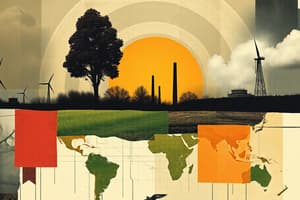Podcast
Questions and Answers
What percentage of marks does the Mid Term exam constitute in the evaluation criteria?
What percentage of marks does the Mid Term exam constitute in the evaluation criteria?
32%
Which of the following is considered as a 'Don't' of the class according to Dr. B.Rajasekhar Reddy's guidelines?
Which of the following is considered as a 'Don't' of the class according to Dr. B.Rajasekhar Reddy's guidelines?
- Use of mobile phones (correct)
- Late coming to class
- Asking questions
- Student involvement
Biofuels are produced from non-renewable biomass feedstocks.
Biofuels are produced from non-renewable biomass feedstocks.
False (B)
In a net-zero emissions world in 2070, _ dominate renewables supply while OIL remains the largest fossil energy source.
In a net-zero emissions world in 2070, _ dominate renewables supply while OIL remains the largest fossil energy source.
Match the following types of renewable energy with their descriptions:
Match the following types of renewable energy with their descriptions:
What is the process for producing ethanol from sugar or starch?
What is the process for producing ethanol from sugar or starch?
Which oilseed crop has an oil content of 40 - 45%?
Which oilseed crop has an oil content of 40 - 45%?
__________ is a highly crystalline fiber that provides strength in biomass.
__________ is a highly crystalline fiber that provides strength in biomass.
Match the components of biomass with their descriptions:
Match the components of biomass with their descriptions:
What is the directional linear structure of a cellulose chain composed of?
What is the directional linear structure of a cellulose chain composed of?
Flashcards are hidden until you start studying
Study Notes
Course Structure and Objectives
- Course structure: assignment, project, mid-term, and end exam
- Evaluation criteria: assignment (10%), project (10%), mid-term (32%), and end exam (48%)
- Do's and don'ts of the class: student involvement, questions, and late coming
- Prohibited activities: mobile phone use, murmuring, and disturbing the class
Global Energy Scenario
- Global proved oil, gas, and coal reserves (BP Statistical Review of World Energy, 2017)
- Increase in energy demand from non-OECD countries (India and China) (International Energy Outlook, 2017)
- World primary energy consumption by sectors and sources (International Energy Outlook, 2017)
Bioenergy
- Definition: energy from renewable biomass feedstocks (plant oils, sugary/starchy parts of crops, trees, waste, algae)
- Cycle of biomass: growth, harvest, conversion, and use
- Why use bioenergy: gas shortage, environmental concerns, and energy security
Types of Biofuels
- First-generation biofuels: ethanol from sugar/starch, biodiesel from vegetable oil
- Second-generation biofuels: thermochemical, enzymatic, and microbial conversion of biomass
- Third-generation biofuels: algae-based biofuels
- Fourth-generation biofuels: advanced biofuels from genetically modified organisms
Advantages and Disadvantages of Biofuels
- Advantages: renewable, sustainable, and reduced greenhouse gas emissions
- Disadvantages: land use, water scarcity, and food vs. fuel debates
Lignocellulosic Biomass
- Components: cellulose, hemicellulose, and lignin
- Structure of lignocellulosic biomass: hierarchical, complex, and crystalline
Representation of Lignin Carbohydrate Complex
- Illustration of the complex structure of lignocellulosic biomass (Clark and Deswarte, 2015)
Studying That Suits You
Use AI to generate personalized quizzes and flashcards to suit your learning preferences.




